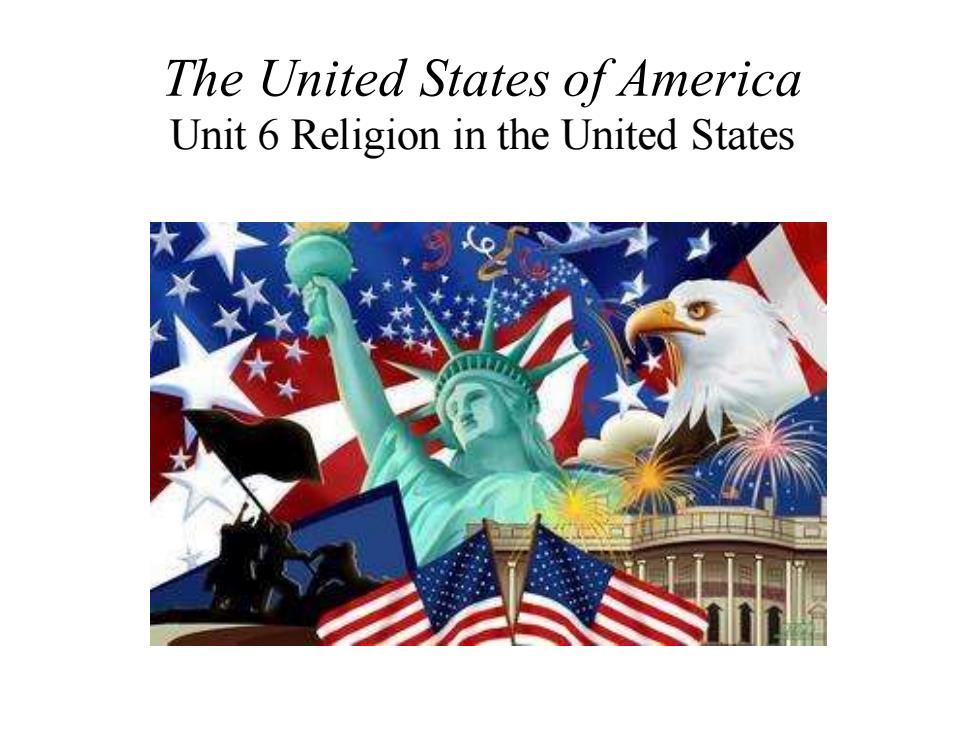
The United States of America Unit 6 Religion in the United States
The United States of America Unit 6 Religion in the United States
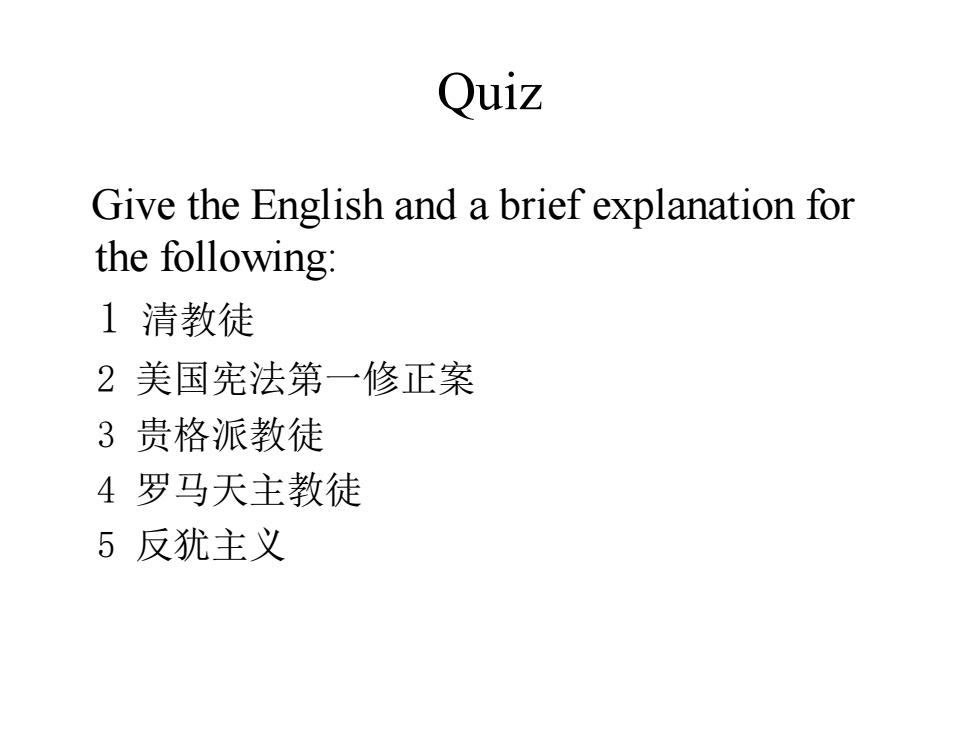
Quiz Give the English and a brief explanation for the following: 1清教徒 2美国宪法第一修正案 3贵格派教徒 4罗马天主教徒 5反犹主义
Quiz Give the English and a brief explanation for the following: 1 清教徒 2 美国宪法第一修正案 3 贵格派教徒 4 罗马天主教徒 5 反犹主义
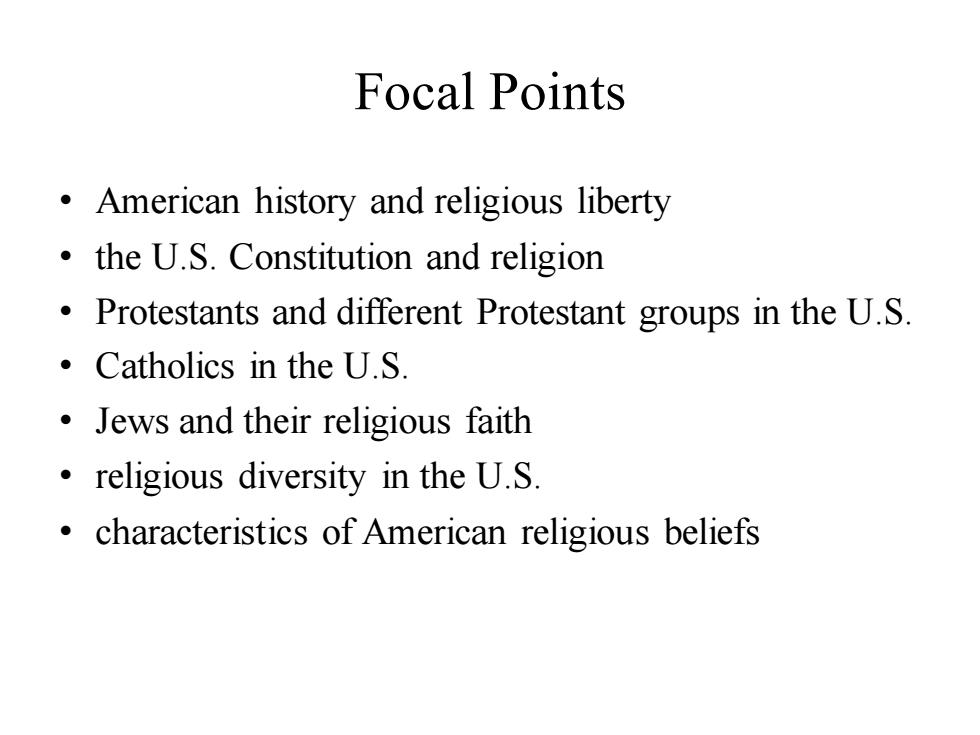
Focal Points American history and religious liberty the U.S.Constitution and religion Protestants and different Protestant groups in the U.S. ·Catholics in the U.S. Jews and their religious faith religious diversity in the U.S. characteristics of American religious beliefs
Focal Points • American history and religious liberty • the U.S. Constitution and religion • Protestants and different Protestant groups in the U.S. • Catholics in the U.S. • Jews and their religious faith • religious diversity in the U.S. • characteristics of American religious beliefs
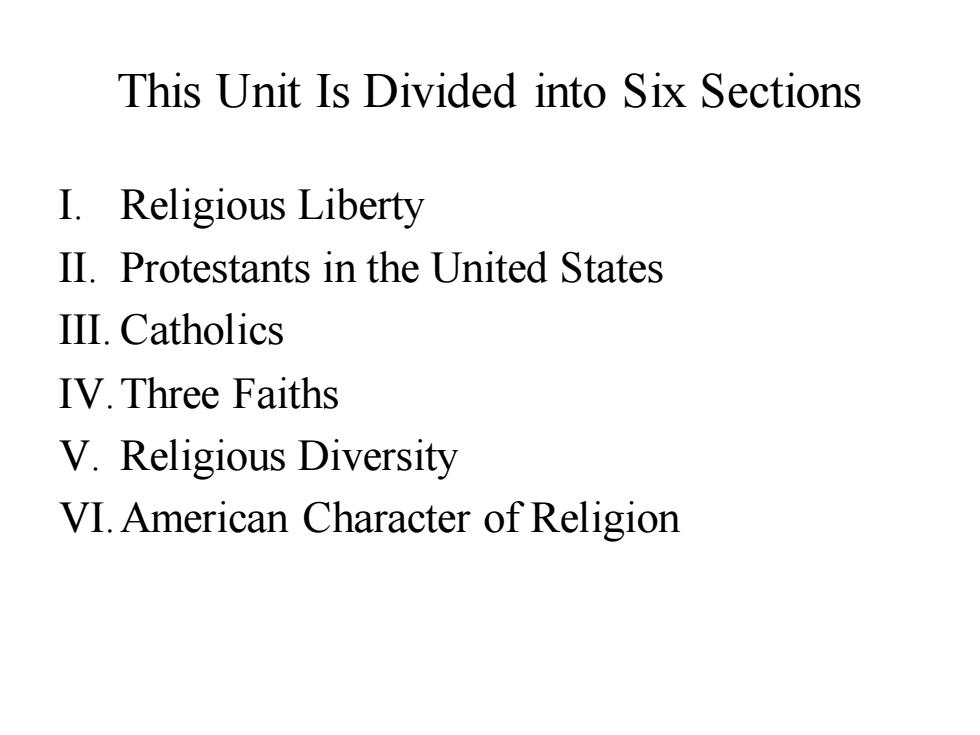
This Unit Is Divided into Six Sections I.Religious Liberty II.Protestants in the United States III.Catholics IV.Three Faiths V.Religious Diversity VI.American Character of Religion
This Unit Is Divided into Six Sections I. Religious Liberty II. Protestants in the United States III. Catholics IV.Three Faiths V. Religious Diversity VI.American Character of Religion

I.Religious Liberty By the middle of the 18th century,many different kinds of Protestants-Lutherans,the Dutch Reformed Church,Presbyterians, Huguenots and Puritans--lived in harmony in America. The Declaration of Independence states,"all men are created equal, that they are endowed by their creator with certain unalienable rights.Among the rights,as a political necessity in a religiously diverse society,was freedom of religion. The First Amendment to the Constitution of the United States forbade the new federal government to give special favors to any religion or to hinder the free practice,or exercise,of religion Various religious faiths have flourished,as well as perished,in the United States
I. Religious Liberty • By the middle of the 18th century, many different kinds of Protestants—Lutherans, the Dutch Reformed Church, Presbyterians, Huguenots and Puritans--lived in harmony in America. • The Declaration of Independence states, “all men are created equal, that they are endowed by their creator with certain unalienable rights.” Among the rights, as a political necessity in a religiously diverse society, was freedom of religion. • The First Amendment to the Constitution of the United States forbade the new federal government to give special favors to any religion or to hinder the free practice, or exercise, of religion. • Various religious faiths have flourished, as well as perished, in the United States
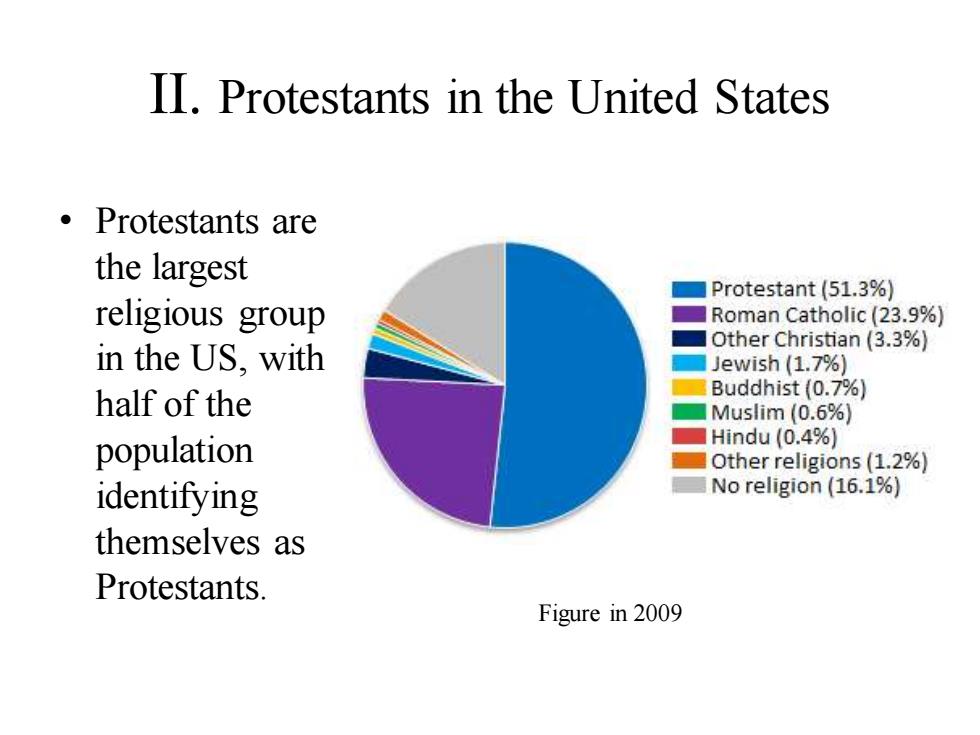
II.Protestants in the United States 。Protestants are the largest Protestant (51.3%) religious group Roman Catholic(23.9%) Other Christian(3.3%) in the US,with Jewish (1.7%) half of the Buddhist(0.7%】 Muslim (0.6%) population Hindu (0.4%) Other religions(1.2%) identifying No religion (16.1%) themselves as Protestants. Figure in 2009
II. Protestants in the United States • Protestants are the largest religious group in the US, with half of the population identifying themselves as Protestants. Figure in 2009

II.Protestants in the United States The Baptists are the largest Protestant group.They believe in adult baptism by immersion,symbolizing a mature and responsible conversion experience.In 2009,the denomination had 1.3 million members in over 5000 churches in the US.(Below is the newly built Fairview Baptist Church in South Carolina)
II. Protestants in the United States • The Baptists are the largest Protestant group. They believe in adult baptism by immersion, symbolizing a mature and responsible conversion experience. In 2009, the denomination had 1.3 million members in over 5000 churches in the US. (Below is the newly built Fairview Baptist Church in South Carolina)
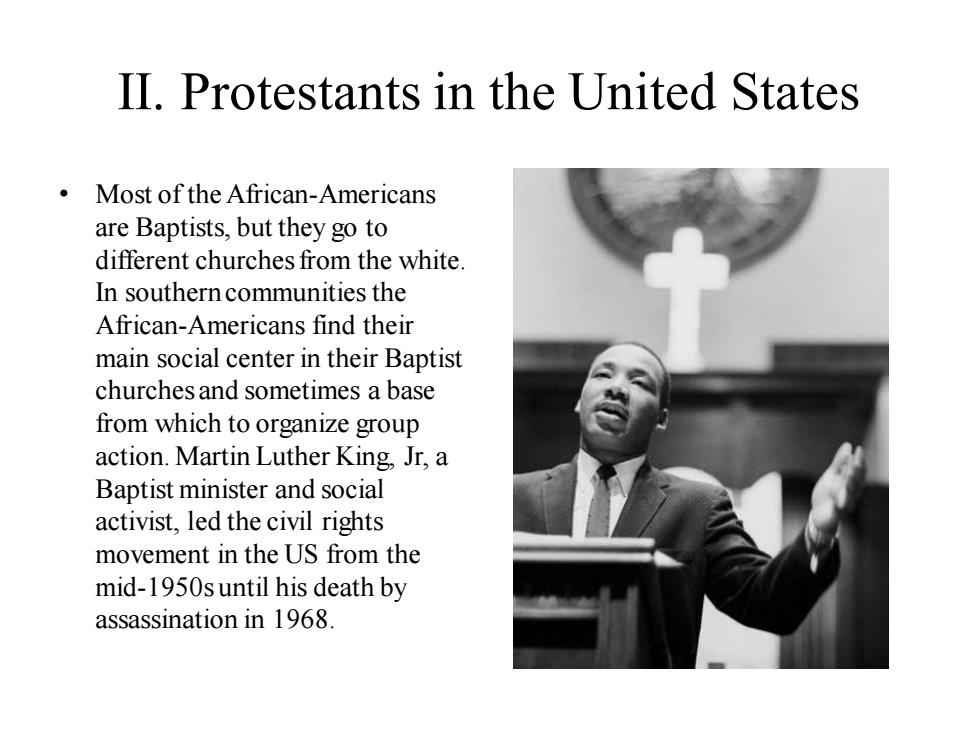
II.Protestants in the United States Most of the African-Americans are Baptists,but they go to different churches from the white. In southern communities the African-Americans find their main social center in their Baptist churches and sometimes a base from which to organize group action.Martin Luther King,Jr,a Baptist minister and social activist,led the civil rights movement in the US from the mid-1950s until his death by assassination in 1968
II. Protestants in the United States • Most of the African-Americans are Baptists, but they go to different churches from the white. In southern communities the African-Americans find their main social center in their Baptist churches and sometimes a base from which to organize group action. Martin Luther King, Jr, a Baptist minister and social activist, led the civil rights movement in the US from the mid-1950s until his death by assassination in 1968

II.Protestants in the United States The Methodists are next to the Baptists,the most numerous Protestants. The Methodists are adherents of the group which grew up in 18th century England.Most Methodists are united in the Methodist Church, which has a form of service based on that of the Church of England. (Right:Boston Avenue Methodidst Church)
II. Protestants in the United States • The Methodists are next to the Baptists, the most numerous Protestants. The Methodists are adherents of the group which grew up in 18th century England. Most Methodists are united in the Methodist Church, which has a form of service based on that of the Church of England. (Right: Boston Avenue Methodidst Church)
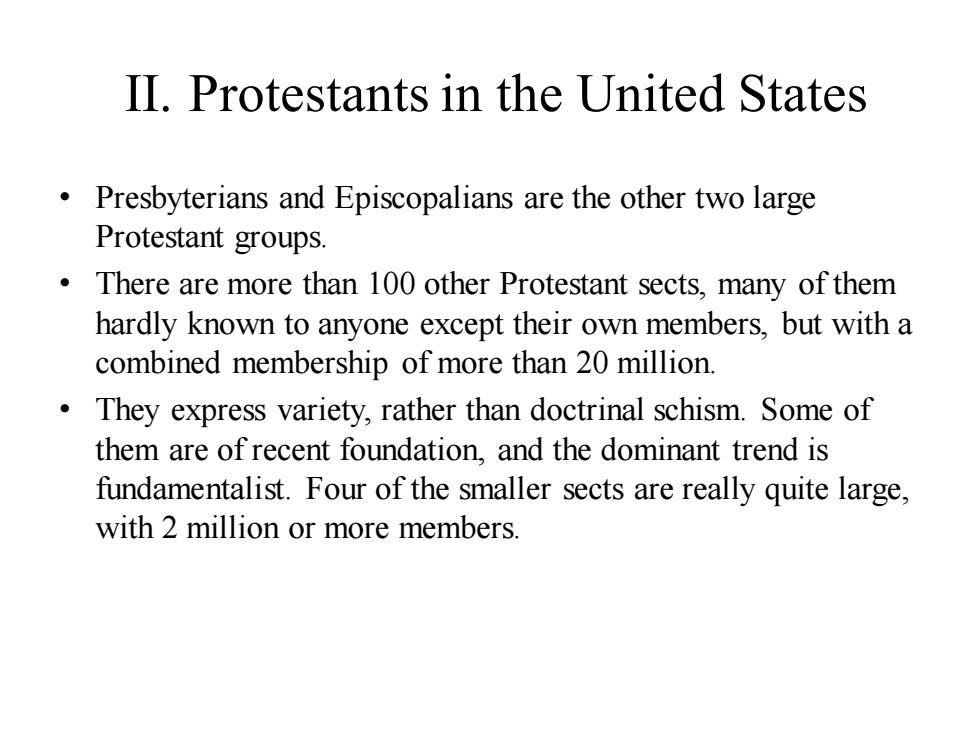
II.Protestants in the United States Presbyterians and Episcopalians are the other two large Protestant groups. There are more than 100 other Protestant sects,many of them hardly known to anyone except their own members,but with a combined membership of more than 20 million. They express variety,rather than doctrinal schism.Some of them are of recent foundation,and the dominant trend is fundamentalist.Four of the smaller sects are really quite large, with 2 million or more members
II. Protestants in the United States • Presbyterians and Episcopalians are the other two large Protestant groups. • There are more than 100 other Protestant sects, many of them hardly known to anyone except their own members, but with a combined membership of more than 20 million. • They express variety, rather than doctrinal schism. Some of them are of recent foundation, and the dominant trend is fundamentalist. Four of the smaller sects are really quite large, with 2 million or more members